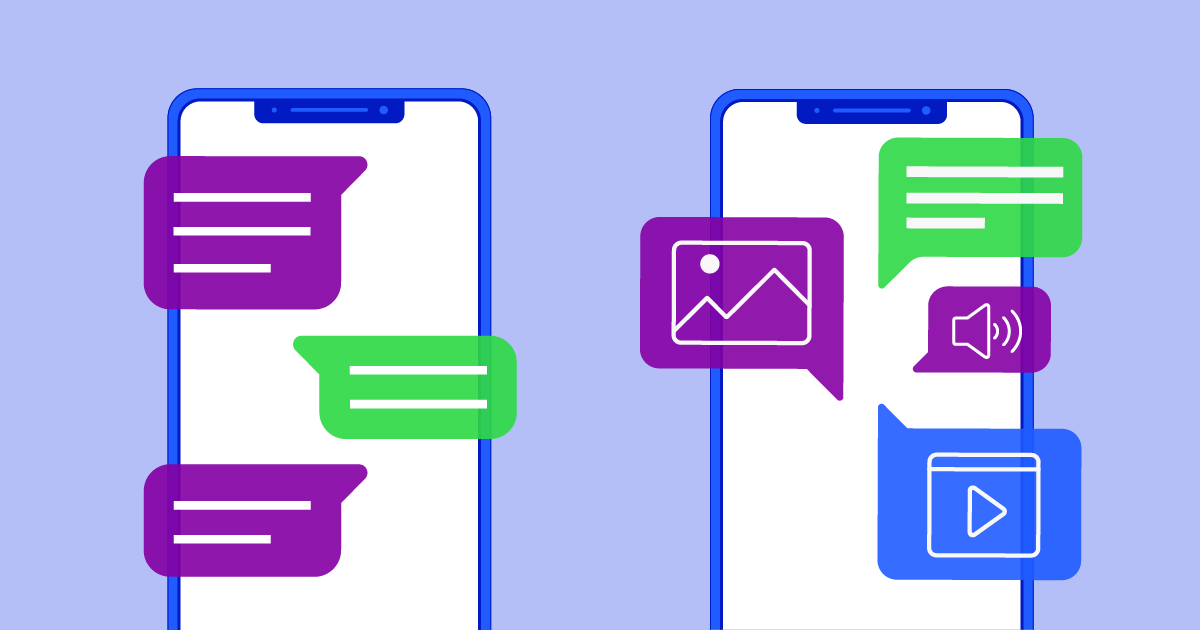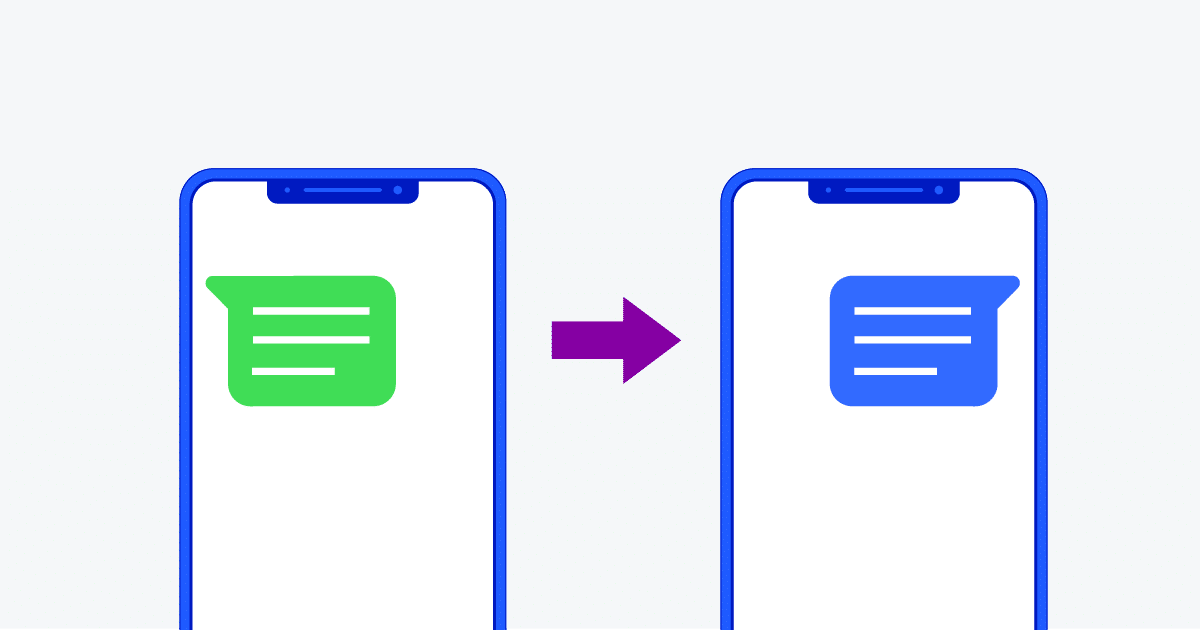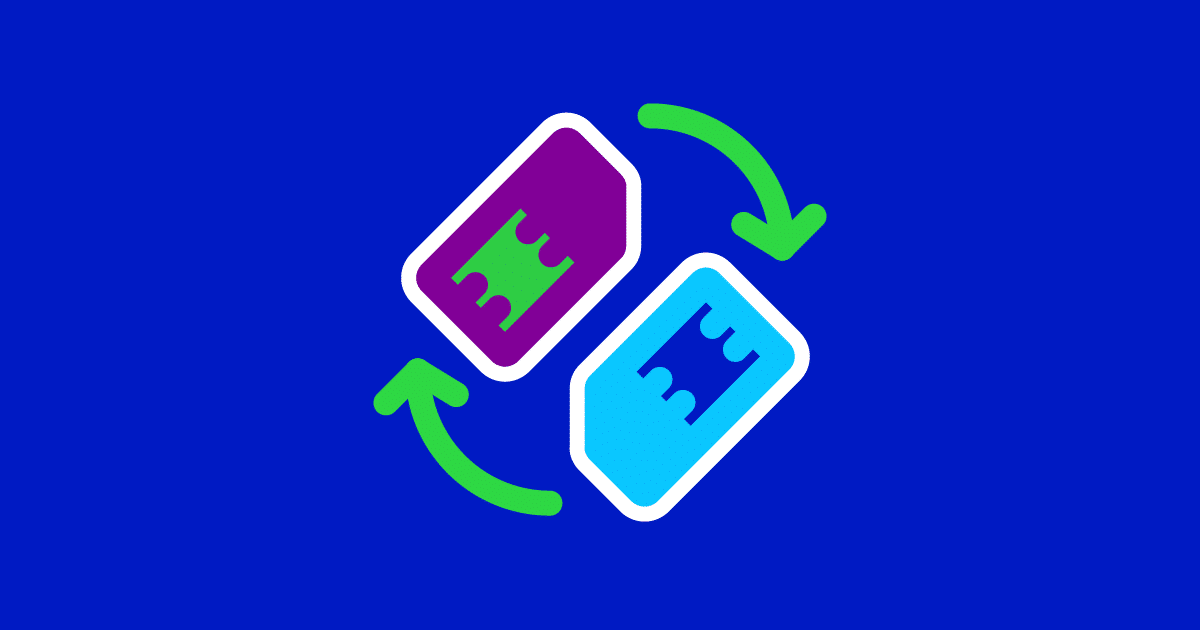
These days, sending text messages is a standard practice in most people’s daily lives. Such a popular form of communication has so many technologies surrounding it, all with unique ways to carry a message from one person to another.
How well do you know the protocols that allow your smartphone or mobile device to send and receive text messages? You’ve probably heard of SMS before, and maybe MMS as well. But do you know what they are, and their key differences?
This article dives into how SMS and MMS function, the differences between them, who should use them, and for what reasons.
Table of Contents
What is SMS?
SMS, or Short Messaging Service, is the most popular form of text messaging, and is used on many smartphones and other mobile devices. The standard character length of an SMS is 160 characters.
An SMS from a marketing campaign, for example, might have details about an upcoming sale, and may include a link for the user to click.
What is MMS?
MMS, or Multimedia Messaging Service, allows users to add various media sources to messages on a smartphone and send or receive them. These sources include things such as images, video, and audio files.
For example, a user may send an MMS if they want to provide more insight or engagement into something than text allows, such as a picture of something they’re describing.
Despite the growth of over the top (OTT) messaging platforms, such as WhatsApp, there’s been continued growth of SMS and MMS messaging. Before we explain why this might be the case, let’s look at some differences between these two types of messaging.
SMS vs MMS: key differences
SMS and MMS both refer to text messaging, and they are a way users send messages to one another using a mobile device, such as a smartphone or similar devices. The main differences show in character length, cost, and content.
To send SMS and MMS messages, you’ll first need some sort of data and/or text messaging plan through a wireless service. An SMS allows 160-character messages, while an MMS allows 1,600.
Cost
When weighing the costs of SMS and MMS, only a few cents can make up a significant cost difference for companies sending out mass messaging campaigns.
SMS is typically at a lower cost than MMS, as it has less text and doesnt include data-heavy components like audio, images, and video.
Use cases
Apart from all the technical details of SMS and MMS, the two services differ distinctly in their use-cases. Things that would make sense to send using MMS might be useless via SMS, and vice-versa. Here are some of the most common use-cases for each.
SMS use-cases
- MFA (multi-factor authentication). Think passcodes sent via text to help a user access their account.
- Appointment reminders. Advances in technology have allowed us the luxury to receive reminders about various appointments, from healthcare to meetings. An SMS is the perfect way to send these out as well.
- Customer satisfaction surveys. Getting immediate feedback is important, and SMS allows companies to quickly send out requests for it.
- Notifications and confirmations. A notification doesn’t need to be loaded with information, images, videos, etc. It can be a brief text message letting a customer know that they’ve completed something successfully, made a successful transaction, etc.
MMS use-cases
- Product photos. If you’re showing off a current, new, or upcoming product, it’s best done with images. MMS are perfect for letting customers know what you’ve got cooking.
- Cart abandonment message. It used to be that companies would send these out via SMS, but the image of a left-in-cart product is a better reminder of what the customer is missing out on.
- Environmental spacing demo. If you’re sending notifications about an event, a video gives the recipient a good idea of the space they’ll be walking into when they arrive.
- Service demonstrations. What kind of service can you offer your customers? How will they know you have exactly what they need? A video demonstrating your service in action from start to finish could be the difference.
- Communication clarity. When text isn’t enough to relay what you’re trying to say, an image is needed, and MMS is required. For example, if someone uses a third-party service for shopping, their shopper may send them a photo of a potential food item replacement to ensure they get the right one.
Advantages of using SMS
Here are the key advantages of using SMS.
- Savings galore. SMS is cheaper than MMS. If you’re trying to get a message out using only text, SMS costs will be lower because of the lower data usage involved.
- Small messages. Big ideas. SMS messages are available for bulk texting that is carrier-verified. This is significant for companies looking to send out messages about their latest products or campaigns en masse.
- Speed is a factor. For those concerned about the speed and efficiency of delivery, SMS has the edge. Because of the short messages, SMS will be sent and received quicker.
- There’s beauty in simplicity. Some may see the restrictive character limits of SMS as negative, but there’s no reason it has to be. Often, especially when marketing teams create messages, there’s creativity sparked by restriction. It also won’t take as much time to pump out shorter messages.
Downsides to SMS
Space limitations. Because SMS limits characters to 160 per message, there’s less room to explain all the details of a campaign, product, or service. There’s also a chance companies sending SMS messages will have to edit and trim their important brand messages to fit the parameters.
Text-only. Always. Being limited to text makes it harder to get a point across, especially if that point needs to be explained visually. Even something like an emoji can change the way a user interprets a message. Furthermore, linking to an image, video, or audio clip is unlikely to be effective, as users might interpret a link as spam or phishing.
Advantages of using MMS
More than a cold open. If you’re sending out texts for a campaign announcement, the chances are that a user will view them more than if you’d sent an email. However, opening is only half the battle. Studies show that MMS inspires higher engagement, thanks to the rich details and visuals included in each message.
A picture is worth 1,000 words. We’re not all poets, able to captivate our audience with a perfectly-written sentence. With MMS, we can make-up for this deficiency through other forms of media, which are often the preferred way users want to engage with a message anyway.
(Nearly) Limitless space. Though it’s not typical for messages to need the entire 1,600 character limit, it’s comforting to have when needed.
Downsides to MMS
Steep costs. The price of MMS will generally be higher, due to the longer text permitted, as well as the inclusion of things like images and videos. These things use more data, which makes the message cost more.
Exclusive club. Unfortunately, not everyone keeps up with technological advances. For customers who haven’t upgraded their flip phone to a modern smartphone, they will be unable to receive MMS messages.
The burden is on…you? Even if a customer you’re sending messages to has a smartphone and can receive MMS, that doesn’t mean they’ve opted-in to receive them in their data plan. If the burden lands on them to pay extra for your announcement MMS, they’re not going to be thrilled.
How do OTT and OTT applications differ from SMS and MMS?
Communication platforms like WhatsApp, Facebook Messenger, Skype, and others are considered OTT. These apps allow users to send messages, typically both text and multimedia formats, to other users.
One of the key differences between these and SMS and MMS is that it’s free to send messages on an OTT platform, as they don’t use data from a cellular service plan, and instead use the Wi-Fi that the phone is connected to.
The differences in usage can be seen geographically, as some countries have users who are less inclined to have wireless service plans than others, making the OTT more appealing.
Use Telesign for safe SMS and MMS
There are plenty of reasons people continue to use SMS and MMS messaging, including reaching a wider audience, reaching a small group of specific people (those without smartphones, for example), and the efficiency and ease-of-use.
The problem companies face when using SMS and MMS messages is that they can be unsecured, leaving problems and trust concerns behind for their users.
Some of the most common problems are phishing and SIM swaps. Because of how vulnerable a company’s end-user can be to these types of fraud and attacks, there is a need for secure SMS and MMS messaging.
If you need a safe way to send SMS and MMS, Telesign has a trusted, global, programmable API to ensure your message is received loud, clear, safely, and on-time.
Telesign’s SMS API keeps your text messages protected, while allowing you to connect faster and easier with your customers.


